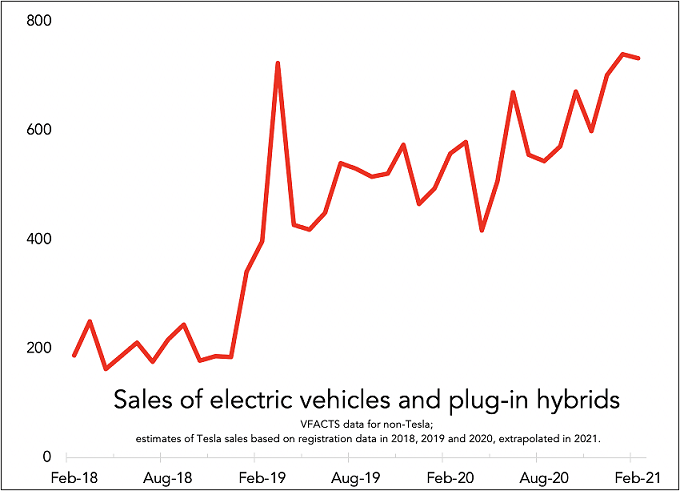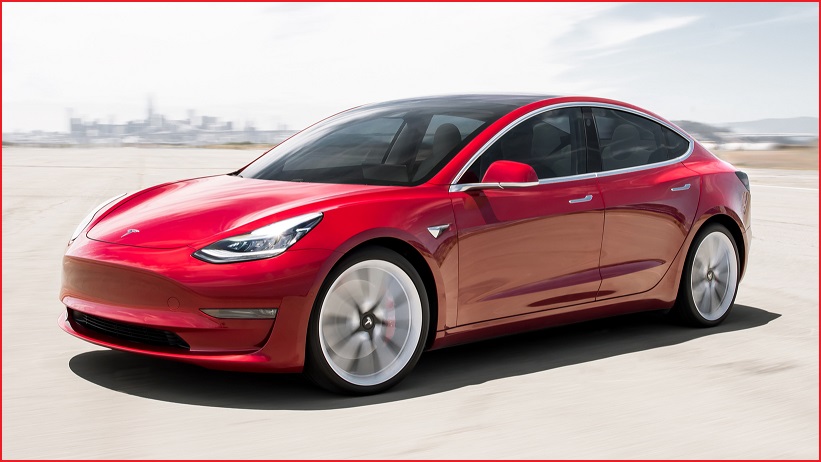Ever wanted an electric vehicle (EV)? A record boatload just landed in Australia.
The Australian Bureau of Statistics usually keeps detailed import data secret, but this week revealed astonishing details about the contents of ships coming into Australia.
Imports of electric vehicles rose 485 per cent last month the Bureau said, as a whopping $125 million worth of electric vehicles landed in Australia.
Imports of hybrids also doubled to $190 million.
February was the biggest month on record for electric vehicle imports, according to ABS Head of International Statistics, Andrew Tomadini.
No doubt Teslas are among those rolling off giant cargo ships, but the EV market is about more than just the Elon Musk-helmed company now.
There are twelve electric vehicle models on sale in Australia. From cheapest to most expensive they are: MG ZS, Nissan LEAF, Hyundai Ioniq, Hyundai Kona, Tesla Model 3, BMW i3, Jaguar iPace, Tesla Model S, Mercedes-Benz EQC, Audi e-Tron, Tesla Model X and Porsche Taycan.
This last car, the Taycan, went on sale in Australia in January and has moved an impressive 64 units so far in 2021, despite costing between $200,000 and $400,000.
But the EVs you will see on the road in big numbers are from Tesla with their three models, and MG (once a British motoring icon, now a brand name owned by Chinese megacorp SAIC).
Tesla accounted for two-thirds of EV sales in Australia before MG’s arrival.
But MG is talking about selling 3,000 of its small SUVs in this country in 2021 and the price makes that a real possibility.
The electric version of MG’s small SUV, the ZS, costs $43,990 drive away, attracting many who’ve been drooling over electric vehicles for years.
The ZS is cheap for an EV, but of course the petrol version starts at just $21,990.
The upfront premium for being battery-driven is still material, and until there are big subsidies purchasers need in order to save a lot of tanks of fuel to justify the difference.
Despite a lack of government support, electric vehicles are winning in an Australian market where total car sales are falling.
Petrol vehicle sales are down from over 60,000 per month two years ago to under 50,000 a month now – a serious fall.
Diesel sales have also ebbed despite the increasing share of big Hiluxes and Ford Rangers in the Australian vehicle mix.
But hybrids, plug-in-hybrids, and electric vehicles are zooming ahead.
Hybrid sales have been on fire in Australia.
They rose five-fold between February 2018 and February 2020, from 1,000 a month to 5,000 a month, before pausing at that level over the last year (perhaps due to declining use of taxis and Ubers).

But even as hybrid sales stalled, electric vehicles kept growing in 2020-21, as the graph shows. (Note: it relies on estimates and projections for Tesla sales, as their sales data is not public.)
The fall in total vehicle sales is not just an Australian phenomenon, but seen across the developed world.
One theory is people are on a vehicle-buying strike, eking out the lives of their current petrol cars a little longer, until affordable EVs come out.
In this theory, there will be an enormous rush of EV-buying once supply is sufficient.










